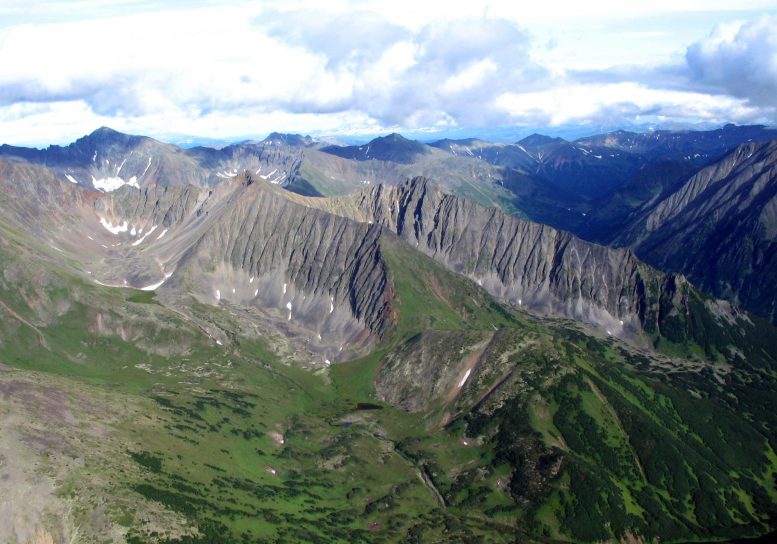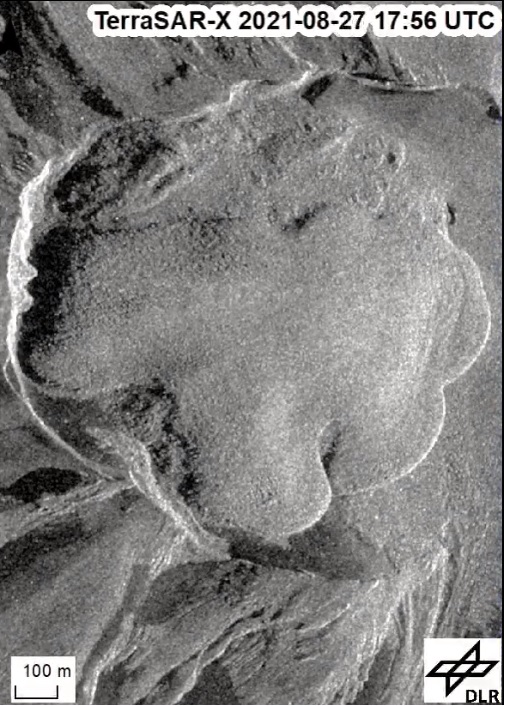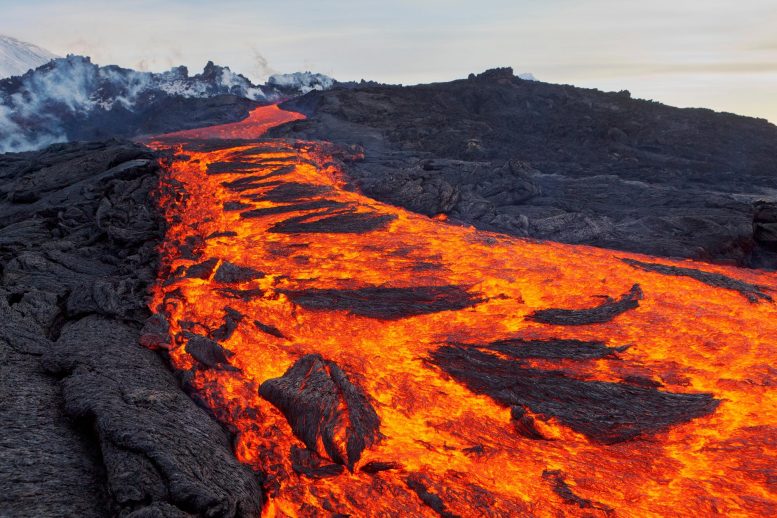Extensive Chains of Volcanoes Provides Safety Valve for Earth’s Long-Term Climate
Extensive chains of volcanoes have been responsible for both emitting and then removing atmospheric carbon dioxide (CO2), stabilizing temperatures at Earth’s surface.
An international research team explored the combined impact of processes in the Earth, oceans, and atmosphere over the past 400 million years. Their findings are published in the journal Nature Geoscience.
The researchers included scientists from the University of Leeds, University of Southampton, University of Sydney, Australian National University (ANU), and the University of Ottawa.
Co-author Dr. Andrew Merdith, of Leeds’ School of Earth and Environment, said: “The work understates the importance of the connectivity and dependence between different Earth systems, each occurring on different scales in time and space.
“Unfortunately, the connectivity and response between the different systems isn’t necessarily instantaneous, and effects can lag their processes by millions of years.”

Continental volcanic arcs such as this one in Kamchatka, Russia, are rapidly weathered, driving CO2 removal from the atmosphere over geological time. Credit: Tom Gernon, University of Southampton
Locking up CO2
Natural breakdown and dissolution of rocks on Earth’s surface is called chemical weathering.
The process is critically important because the products of weathering – elements such as calcium and magnesium – are flushed via rivers to the oceans, where they form minerals that lock up CO2.
This feedback mechanism regulates atmospheric CO2 levels, and in turn global climate, over geological time.
Lead author of the report is Dr. Tom Gernon, Associate Professor in Earth Science at the University of Southampton, and a Fellow of the Turing Institute.
He said: “In this respect, weathering of the Earth’s surface serves as a geological thermostat.
“But the underlying controls have proven difficult to determine due to the complexity of the Earth system.”
Eelco Rohling, Professor in Ocean and Climate Change at ANU and co-author of the study, said: “Many Earth processes are interlinked, and there are some major time lags between processes and their effects.
“Understanding the relative influence of specific processes within the Earth system response has therefore been an intractable problem.”
To unravel the complexity, the team constructed a novel ‘Earth network’, incorporating machine-learning algorithms and state-of-the-art plate tectonic reconstructions.
This enabled them to identify the dominant interactions within the Earth system, and how they evolved through time.
The team found that continental volcanic arcs were the most important driver of weathering intensity over the past 400 million years.
Chains of volcanoes
Today, continental arcs comprise chains of volcanoes in, for example, the Andes in South America, and the Cascades in the US.
These volcanoes are some of the highest and fastest eroding features on Earth.
Because the volcanic rocks are fragmented and chemically reactive, they are rapidly weathered and flushed into the oceans.
Leeds’ Dr. Merdith added: “The plate-tectonic reconstructions, which describe the position and motion of Earth’s tectonic plates through time, provided a foundation within which our analysis could not only be performed, but also make sense.
“This is because we can extract and approximate a number of tectonic parameters, such as volcanic degassing along arcs, as well as the storage of carbon in oceans through the alteration of new oceanic crust at mid-ocean ridges.”
Martin Palmer, Professor of Geochemistry at the University of Southampton and co-author of the study, said: “It’s a balancing act. On one hand, these volcanoes pumped out large amounts of CO2 that increased atmospheric CO2 levels.
“On the other hand, these same volcanoes helped remove that carbon via rapid weathering reactions.”
The study casts doubt on a long-held concept that Earth’s climate stability over tens to hundreds of millions of years reflects a balance between weathering of the seafloor and continental interiors.
Geological tug of war
Lead author Dr. Gernon added: “The idea of such a geological tug of war between the landmasses and the seafloor as a dominant driver of Earth surface weathering is not supported by the data.
“Unfortunately, the results do not mean that nature will save us from climate change.
“Today, atmospheric CO2 levels are higher than at any time in the past three million years, and human driven emissions are about 150 times larger than volcanic CO2 emissions.
“The continental arcs that appear to have saved the planet in the deep past are simply not present at the scale needed to help counteract present-day CO2 emissions.”
But the team’s findings still provide critical insights into how society might manage the current climate crisis.
Artificially enhanced rock weathering—where rocks are pulverized and spread across land to speed up chemical reaction rates—could play a key role in safely removing CO2 from the atmosphere.
The team’s findings suggest that such schemes may be deployed optimally by using calc-alkaline volcanic materials (those containing calcium, potassium, and sodium), like those found in continental arc environments.
Dr Gernon added: “This is by no means a silver bullet solution to the climate crisis—we urgently need to reduce CO2 emissions in line with IPCC mitigation pathways, full stop.
“Our assessment of weathering feedbacks over long timescales may help in designing and evaluating large-scale enhanced weathering schemes, which is just one of the steps needed to counteract global climate change.”
For more on this research, see Volcanoes Act as a Safety Valve for Earth’s Long-Term Climate – Stabilizing Surface Temperatures.
Reference: “Global chemical weathering dominated by continental arcs since the mid-Palaeozoic” by Thomas M. Gernon, Thea K. Hincks, Andrew S. Merdith, Eelco J. Rohling, Martin R. Palmer, Gavin L. Foster, Clément P. Bataille and R. Dietmar Müller, 23 August 2021, Nature Geoscience.
DOI: 10.1038/s41561-021-00806-0
Great Sitkin volcano (Aleutian Islands,
Alaska): actively growing lava dome
reached over 1 km width

The effusive eruption of the volcano continues to be elevated during the past week.
The active lava dome continues to grow with magma rising into it as confirmed by a new satellite data that depicts the dark mass of fresh viscous lava that has been accumulating on the summit crater.
The extruded lava dome is currently about 3,600 ft (1,090 m) wide detected on 30 August in comparison with parameters from 19 August (2,800 ft (860 m) as reported by the Alaska Volcano Observatory (AVO).
A series of small earthquakes have been detected over the last week which might be related as a response to the extrusive eruption at the volcano.
There is no indication of how long the lava effusion will continue during the current eruption and it is possible that explosive activity could occur with little or no warning.
An impressive series of high-resolution satellite radar (SAR) images of the lava dome growing process from 25 July to 27 August have been published by Simon Plank from German Aerospace Center (DLR) as visible in the GIF animation below.
Source: Alaska Volcano Observatory volcano activity update 4 September 2021
GIF animation of the lava dome growing during the last month (source: Simon Plank/German Aerospace Center)
- All news about: Great Sitkin volcano
- Information about: Great Sitkin volcano

No comments:
Post a Comment